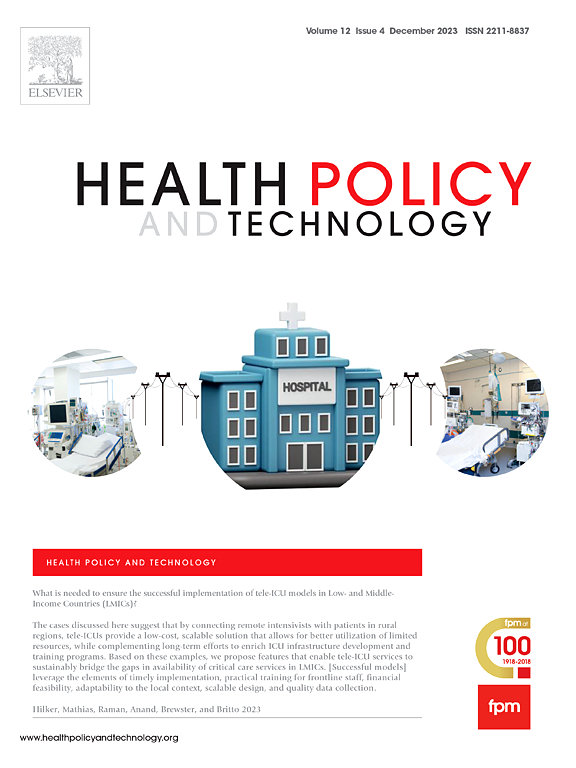Diverse structures and methods of national health technology assessment organizations: A scoping review
IF 3.4
3区 医学
Q1 HEALTH POLICY & SERVICES
引用次数: 0
Abstract
Objectives
To explore the structure and methods of health technology assessment (HTA) organizations.
Methods
We included organizations that conduct HTA to inform coverage/reimbursement decisions nationally in any country. Eligible organizations were identified through a systematic search of well-known HTA networks (International Network for Agencies for HTA [INAHTA], European Network for Health Technology Assessment [EUnetHTA], Red de Evaluación de Tecnologías en Salud de las Americas [RedETSA], HTAsiaLink) and references from previous studies evaluating HTA organizations.
Results
We identified 69 organizations, from 56 countries. Most organizations are European (n = 39, 56 %) and governmental (n = 53, 77 %). Fifty-one (74 %) advise health authorities, while 13 (19 %) are the ultimate decision-making authority. Of 62 organizations with known funding, all use public resources, and 12 (17 %) charge a fee for evaluation. Healthcare technologies evaluated are medicines (n = 61, 88 %), devices (n = 47, 68 %), and procedures (n = 33, 48 %). Sixty-six organizations (96 %) consider economic factors, with cost-effectiveness and budget impact analyses being the most conducted evaluations. HTA is usually initiated upon the manufacturer's request (n = 45, 65 %). Patient involvement is not clearly described in 32 organizations (46 %), and 2 (3 %) report no involvement; among the remaining, for most (n = 29, 42 %), the role of patients is to provide information to be considered during the decision-making process.
Conclusions
Our results underscore the diverse landscape of HTA organizations, highlighting both shared methodologies and unique adaptations, a knowledge that is valuable for countries looking to establish or refine their HTA organizations.
Lay summary
Health technology assessment (HTA) is crucial for guiding healthcare decisions and policies around the world. We analyzed 69 organizations from 56 countries that use HTA to inform national coverage and reimbursement decisions. These organizations, primarily government-affiliated, advise on which healthcare technologies—like medications and medical devices—should be funded based mainly on their effectiveness and cost. Despite their common goals, we found significant variation in how they operate, especially in the criteria they use to make recommendations and how they involve stakeholders. Understanding these global practices helps countries improving their own HTA processes, ensuring better healthcare outcomes.
国家卫生技术评价机构的不同结构和方法:范围审查
目的探讨卫生技术评价(HTA)机构的结构和方法。方法我们纳入了在任何国家进行HTA以通知覆盖/报销决定的组织。通过系统搜索知名的HTA网络(国际HTA机构网络[INAHTA]、欧洲卫生技术评估网络[EUnetHTA]、Red de Evaluación de Tecnologías en Salud de las Americas [RedETSA]、HTAsiaLink)和先前评估HTA组织的研究参考文献,确定了符合条件的组织。结果我们确定了来自56个国家的69个组织。大多数组织是欧洲(n = 39,56%)和政府(n = 53,77%)。51家(74%)向卫生当局提供建议,13家(19%)拥有最终决策权。在62家已知资助的机构中,所有机构都使用公共资源,其中12家(17%)收取评估费用。评估的医疗技术包括药物(n = 61, 88%)、设备(n = 47, 68%)和程序(n = 33, 48%)。66个组织(96%)考虑经济因素,成本效益和预算影响分析是进行最多的评估。HTA通常在制造商的要求下启动(n = 45,65 %)。32个组织(46%)没有明确描述患者的受累情况,2个组织(3%)报告没有受累;其中,对于大多数(n = 29,42 %),患者的作用是提供决策过程中需要考虑的信息。我们的结果强调了HTA组织的多样性,强调了共享的方法和独特的适应方式,这对希望建立或完善其HTA组织的国家来说是有价值的。卫生技术评估(HTA)对于指导世界各地的卫生保健决策和政策至关重要。我们分析了来自56个国家的69个组织,这些组织使用HTA为国家保险和报销决策提供信息。这些组织主要隶属于政府,主要根据药物和医疗设备的有效性和成本为医疗技术(如药物和医疗设备)提供投资建议。尽管它们有共同的目标,但是我们发现它们的运作方式存在显著差异,特别是在它们用来提出建议的标准以及它们如何涉及涉众方面。了解这些全球实践有助于各国改进自己的HTA流程,确保获得更好的医疗保健结果。
本文章由计算机程序翻译,如有差异,请以英文原文为准。
求助全文
约1分钟内获得全文
求助全文
来源期刊

Health Policy and Technology
Medicine-Health Policy
CiteScore
9.20
自引率
3.30%
发文量
78
审稿时长
88 days
期刊介绍:
Health Policy and Technology (HPT), is the official journal of the Fellowship of Postgraduate Medicine (FPM), a cross-disciplinary journal, which focuses on past, present and future health policy and the role of technology in clinical and non-clinical national and international health environments.
HPT provides a further excellent way for the FPM to continue to make important national and international contributions to development of policy and practice within medicine and related disciplines. The aim of HPT is to publish relevant, timely and accessible articles and commentaries to support policy-makers, health professionals, health technology providers, patient groups and academia interested in health policy and technology.
Topics covered by HPT will include:
- Health technology, including drug discovery, diagnostics, medicines, devices, therapeutic delivery and eHealth systems
- Cross-national comparisons on health policy using evidence-based approaches
- National studies on health policy to determine the outcomes of technology-driven initiatives
- Cross-border eHealth including health tourism
- The digital divide in mobility, access and affordability of healthcare
- Health technology assessment (HTA) methods and tools for evaluating the effectiveness of clinical and non-clinical health technologies
- Health and eHealth indicators and benchmarks (measure/metrics) for understanding the adoption and diffusion of health technologies
- Health and eHealth models and frameworks to support policy-makers and other stakeholders in decision-making
- Stakeholder engagement with health technologies (clinical and patient/citizen buy-in)
- Regulation and health economics
 求助内容:
求助内容: 应助结果提醒方式:
应助结果提醒方式:


